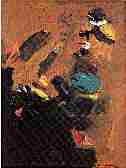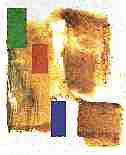Hans Hofmann: Works and Teachings
Robert Sievert
 Hans Hofmann: "Golden Dust"
Hans Hofmann: "Golden Dust"
 Hans Hofmann: "Orpheus"
Hans Hofmann: "Orpheus"
Then why does Hofmann's work represent such a problem to others and me? Some love it. It is clearly the demonstration of mastery as far as spatial construction goes. Does it have a great sense of depth? Well, sort of! When one is confronted with a Hofmann canvas, the first impression is a flat space; one does not see the "expansive" space until further regard. Do his paintings convey the sensitivity to form that makes De Kooning so wildly exciting? No! Somehow they seem very blunt and clumsy. The materials do not transcend themselves and the paint remains paint.
Paint remaining paint remained a battle cry for many years in the underworld of New York painting. To be in the "New York School" meant to have a certain "weight" of paint. This process oversteps the traditional transformative nature in art by which a daub of paint becomes a pearl or other object. Hofmann was a longtime voice of authority in the "Artist Club," a downtown meeting of New York artists in the heyday of Abstract Expressionism.
It is important to distinguish between the teaching and the work of Hans Hofmann. His teaching clearly defined a powerful technique while his painting seemed to be an exposition of his teaching technique combined with an attempt to define the future of art with an admiration for the purity of Mondrian.
For Hofmann it was a pure technical display of oil painting. A rendering of theory developed in the studios and cafes of pre WWI Europe and honed in the hot climate of postwar New York art. There was excitement about paint. The most admired artists were the most physically employed in the movement of masses of oil paint on large surfaces. The amount of paint on a canvas and the size of the canvas mattered.
The paintings recently shown at the Metropolitan Museum, The Renate Series, were done when Hofmann was over eighty. They are large, heroic, aggressive paintings that represent the final thinking of some one who struggled for years with the meaning of art and its path into the future. Hofmann was very authoritarian and had worked out elaborate theories. His work was more an effort to solidify these theories and create a new context of painting. In the Renate Series and in the paintings recently shown at Ameringer/Howard Gallery, Hofmann seems to be reviewing the vocabulary of painting: the wash, the heavy impasto, skillful combinations of texture and color are explored. So where does this leave Hofmann? Does he make it as a poetic or lyrical colorist? The colors are aggressively primary. He does not stray from several primary colors and their effects on each other. The approach seems almost scientific and does not pay attention to subtlety. The structures of the work become more and more simple. They seem to lack the sweep and movement which were spoken about in his theory. The pile-up of his forms do not look dynamic. What is most apparent in the late work is the reluctance to stay within his prolonged theory. He moves into immediacy with stains and washes and leaves exposed the white ground of his canvas. The picture plane is assumed, not defined.
Hofmann's work can be compared with Mondrian's. Both sought "pure plasticity," but Mondrian eliminated the "painterly" quality and reduced his work to linear design and primary color. Hofmann was not as ascetic. He searched for purity in simplicity. He always stayed within the confines of the painterly tradition. His paintings have an almost childlike sense of exploration.
The problem I have with both artists' work is that they are successful in only one mood. Primacy is in itself a mood. One where only bright colors vibrate in intense sunniness and one of the true great subjects of art is overlooked and that is mood. Mood is what art is great at conveying and what most look to in art as a touchstone of love. One loves Monet, Vermeer, even Schubert for their ability to touch our hearts.
The impulse to remove secondary material from art and just focus on one or two of its most endemic characteristics always is what artistic utopians have come down to. And what they have given up has alienated them from many "art lovers." I must say that I love Mondrian's early work on flowers and find most of his late work empty. I have gasped at one or two of the simplest of his abstractions in sheer admiration but see the madness of Broadway Boogie Woogie as an idea with nowhere to go.
Hofmann was certainly responsible for the sense of open structure that was one of the keynotes of Abstract Expressionism. His desire to prove his pedagogical theories stood in his way more than it opened new doors. His late work does not have that plastic explosion he taught, but rather the erection of great monoliths of theoretical color.